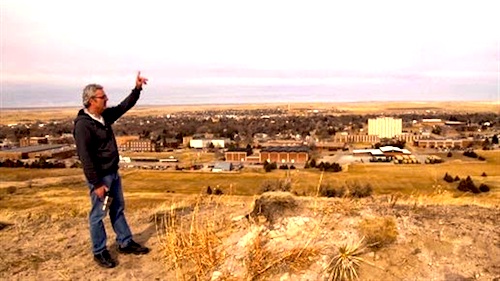By Joe Bendel. It is not easy to recruit a theoretical mathematician to a small college nestled in the middle of nowhere. You would think the administration and the police would be somewhat alarmed when said math professor turned up missing. However, many of Dr. Steven Haataja’s friends and colleagues were troubled by a perceived lack of urgency during the early days of his disappearance. The mystery only deepened further when Haataja’s body was discovered. The case became the central strand of Poe Ballantine’s eccentric true crime ode to his adopted home town. Inspired by Ballantine’s pseudo-memoir, Dave Jannette’s investigates Chadron, Nebraska’s most notorious missing person case in Love and Terror on the Howling Plains of Nowhere, which screens as a Midnight selection of this year’s DOC NYC.
Theoretical math is a young, socially awkward man’s game, so the forty-six year old Haataja was already over the hill when he arrived at Chadron State College. They were still lucky to have someone with his qualifications. In his short time in Chadron, Haataja seemed to be making friends, despite a history of depression. Then one day he vanished. Months later, he was discovered, bound to a tree and unrecognizably burnt to death. Naturally, the Chadron police eventually determined it was suicide.
Yes, Haataja’s hands were apparently free, but it still just did not add up correctly for Ballantine. In the film’s centerpiece sequence, the author retraces Haataja’s alleged final steps under similar below-freezing, nocturnal conditions, finding it hard going, even without a recently mended broken hip. Unfortunately, there will be no definitive closure, just more questions. There is also an awful lot of Ballantine and his family, who are all quite pleasant, but often feel like a bit of a distraction from the existential mystery at hand. Still, Ballantine obviously feels a kinship with Haataja as outsiders who found an unlikely home in off-the-beaten-path Chadron.
Jannette constantly plays up Chadron’s idiosyncratic characters, including some who have no apparent connection to the case, but look suitably exotic on camera. There seems to be an effort to play to the Twin Peaks audience, while leaving some issues underdeveloped. Frankly, the material presented in Howling raises a red flag regarding known victims of depression who subsequently die under suspicious circumstances. How diligently are they investigated or are they commonly dismissed as suicides for the sake of convenience?

Although it would be quite a tangent to follow-up on, it is also rather disconcerting when a colleague explains his attempt to interest The Chronicle of Higher Education in the then missing Haataja was rebuffed because they constantly received similar reports of vanishing academics. You have to wonder just how many of them really do “turn up later.” Nonetheless, his use of the local newspaper’s Police Beat is undeniably funny and in its way, quite telling.
There is something about the Haataja case that is hard to shake off. It festers in the subconscious, crying out for a conclusive verdict, but remains maddeningly obscure. There is also a lot of anger in Howling that is not misplaced. Better as a true crime expose than an exploration of local color, Love and Terror on the Howling Plains of Nowhere is recommended on balance when it screens this Saturday night (11/15) as part of DOC NYC 2014.
LFM GRADE: B
Posted on November 12th, 2014 at 3:13pm.